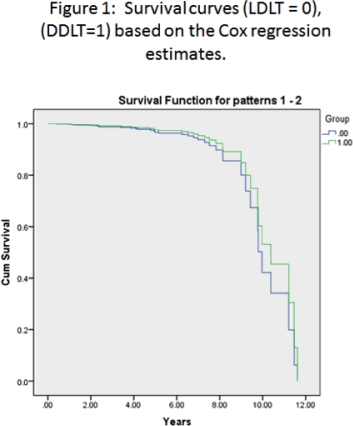Living Donor Liver Transplant Has Similar Outcome to Deceased Donor Liver Transplant for MELD > 25.
M. Al Sebayel,1 F. Abaalkhail,1,2 M. Shoukri,1 H. Albahili,1,2 S. Alabbad,1 W. AlHamoudi,1,2,3 H. Albeshbeshy,1 H. Elsiesy.1,2
1Liver Transplantation, King Faisal Specialist Hospital and Research Center, Riyadh, Saudi Arabia
2Alfaisal University, Riyadh, Saudi Arabia
3Department of Gastroenterology, King Saud University, Riyadh, Saudi Arabia.
Meeting: 2016 American Transplant Congress
Abstract number: 238
Keywords: Liver transplantation, Living-related liver donors, Outcome
Session Information
Session Name: Concurrent Session: Living Donor Liver Transplantation
Session Type: Concurrent Session
Date: Monday, June 13, 2016
Session Time: 2:30pm-4:00pm
 Presentation Time: 3:18pm-3:30pm
Presentation Time: 3:18pm-3:30pm
Location: Room 210
Background and Aims: Model for End-Stage Liver Disease (MELD) score is universally used to prioritize patients on the liver transplant (LT) waiting list. There has been conflicting evidence on the use of living donor liver transplantation (LDLT) in patients with high MELD scores. We reported a single-center retrospective data comparing survival between LDLT and deceased donor liver transplantation (DDLT) for patients with MELD score 25. Methods: Between 2001 and 2015, 603 LT were performed at out institution, of which 308 were LDLT and 298 were DDLT. Of those, 178 patients had MELD score >25 (116 DDLT and 62 LDLT). A retrospective analysis was made on patients with high MELD score evaluating age, gender, history of diabetes, renal impairment (using estimated GFR), hospital stay, ICU stay, MELD score at the time of LT and outcome.
Results: Univariate analysis using non-parametric Mann-Whitney test was performed. The joint effect on the survival rate using the potential risk factors was estimated using Cox regression.
| PRAMETER | P VALUE | HAZARD RATIO |
| AGE | 0.00 | 1.070 |
| GENDER | 0.897 | 0.95 |
| BMI | 0.02 | 0.092 |
| DM | 0.446 | 0.042 |
| RENAL IMPAIRMENT | 0.00 | 1.042 |
| MELD | 0.001 | 1.138 |
| Group | 0.477 | 1.362 |
. The estimated one, three, and five years survival probabilities are given in
| Group | 1 year survival | 3 year survival | 5 year survival |
| LDLT | 0.98 | 0.80 | 0.74 |
| DDLT | 0.97 | 0.94 | 0.85 |
. Age, BMI, renal impairment, MELD score at the time of LT correlated with survival with P value <0.05. The survival between 2 groups was similar 
Conclusions: LDLT has similar outcome to DDLT in patients with high MELD score >25, older age, high BMI, renal impairment and higher MELD has worse outcome in both groups.
CITATION INFORMATION: Al Sebayel M, Abaalkhail F, Shoukri M, Albahili H, Alabbad S, AlHamoudi W, Albeshbeshy H, Elsiesy H. Living Donor Liver Transplant Has Similar Outcome to Deceased Donor Liver Transplant for MELD > 25. Am J Transplant. 2016;16 (suppl 3).
To cite this abstract in AMA style:
Sebayel MAl, Abaalkhail F, Shoukri M, Albahili H, Alabbad S, AlHamoudi W, Albeshbeshy H, Elsiesy H. Living Donor Liver Transplant Has Similar Outcome to Deceased Donor Liver Transplant for MELD > 25. [abstract]. Am J Transplant. 2016; 16 (suppl 3). https://atcmeetingabstracts.com/abstract/living-donor-liver-transplant-has-similar-outcome-to-deceased-donor-liver-transplant-for-meld-25/. Accessed December 16, 2025.« Back to 2016 American Transplant Congress
